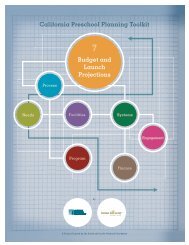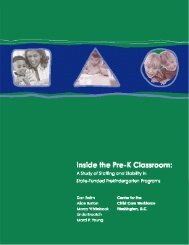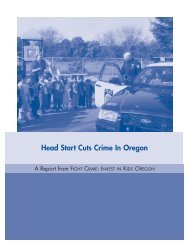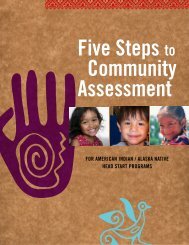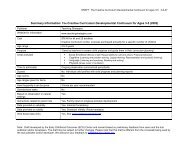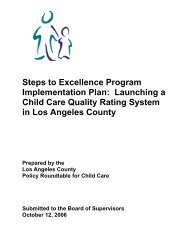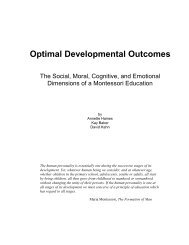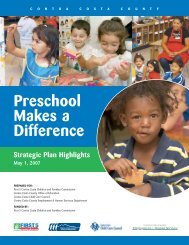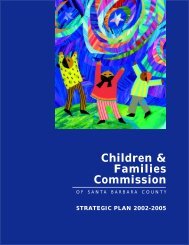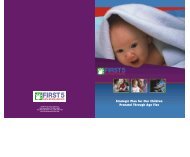Mapping the P-3 Continuum - Foundation for Child Development
Mapping the P-3 Continuum - Foundation for Child Development
Mapping the P-3 Continuum - Foundation for Child Development
You also want an ePaper? Increase the reach of your titles
YUMPU automatically turns print PDFs into web optimized ePapers that Google loves.
IDENTIFY AND DOCUMENT CONCRETE EXAMPLES OF P-3AND THEIR EFFECTSFour early childhood programsImportant lessons ga<strong>the</strong>red from evaluations of four extended early childhood programs <strong>for</strong> lowincomefamilies can in<strong>for</strong>m a P-3 initiative – Head Start Follow Through (1968-1996); Chicago<strong>Child</strong>-Parent Center and Expansion Program (1967-present); Carolina Abecedarian Project(1972-1985); and Head Start/Public School Early <strong>Child</strong>hood Transition Demonstration Project(1991-1998). 7 All of <strong>the</strong>se programs included parent involvement and social and health servicecomponents. Although <strong>the</strong> classroom learning environments differed in <strong>the</strong>ir curricula, allincluded some <strong>for</strong>m of ongoing staff training. Finally, all of <strong>the</strong> programs took place in anelementary school environment in kindergarten through third grade.The goal of Head Start Follow Through was to provide Head Start-like services in publicschools to ensure a smooth transition from preschool through <strong>the</strong> early grades. Due todifficulties in funding and <strong>the</strong> differences between <strong>the</strong> public schools and <strong>the</strong> service orientedprogram, Follow Through became an experiment on <strong>the</strong> effects of instructional methods on <strong>the</strong>educational development of children in kindergarten through third grade. The instructionalmethods employed in <strong>the</strong> study were 1) Direct Instruction, 2) Behavioral Analysis Models, 3)High/Scope Cognitively Oriented Curriculum Model, 4) Parent Education Model, and 5) BankStreet Model of <strong>Development</strong>al-Interaction.Two findings, in particular, are instructional <strong>for</strong> our purposes. First, <strong>the</strong> overall finding was thatinstructional method makes a difference in child outcomes, leading to enhanced educationalsuccess and social and emotional development. Both <strong>the</strong> Direct Instruction and BehavioralAnalysis Models showed stronger effects than <strong>the</strong> High/Scope Cognitively Oriented CurriculumModel, Parent Education Model, and <strong>the</strong> Bank Street Model of <strong>Development</strong>al-Interaction.Second, <strong>the</strong>re was variation in program effectiveness across schools, which was larger than <strong>the</strong>variations among <strong>the</strong> different methods of instruction. This later finding illuminates <strong>the</strong> problemof standardized implementation across schools.The Chicago <strong>Child</strong>-Parent Center and Expansion Program (CPC) is <strong>the</strong> oldest extendedearly childhood intervention, and <strong>the</strong> second oldest federally funded preschool program in <strong>the</strong>U.S. (Head Start is <strong>the</strong> oldest). The program seeks to promote urban low-income, AfricanAmerican and Hispanic children’s academic success and to increase parent involvement. Oneimportant and unique component of <strong>the</strong> CPC program is its central governance through <strong>the</strong>Chicago Public School System, including oversight by <strong>the</strong> school principal. O<strong>the</strong>r componentsinclude pre-school <strong>for</strong> all three-year-olds, parent resource rooms, and reduced class sizes (from35+ to 25). The curriculum focuses on basic skill attainment. Strong parental involvement and<strong>the</strong> provision of follow-on services are equally integral components of <strong>the</strong> program.Essential findings from CPC evaluations include: 1) <strong>Child</strong>ren who participated <strong>for</strong> four or moreyears had higher reading and math achievement in eighth grade, as well as higher rates of7 Reynolds, A. (2003). Key characteristics and implications of working models: Chicago <strong>Child</strong>-Parent Centers.Presentation at <strong>Foundation</strong> <strong>for</strong> <strong>Child</strong> <strong>Development</strong>.6



